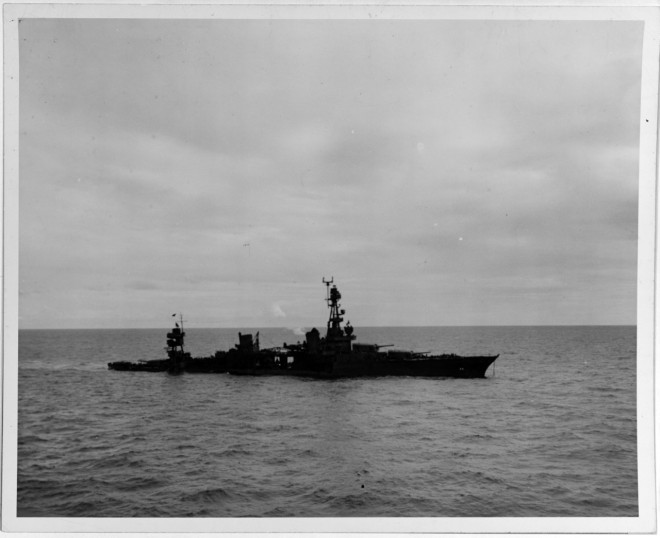The Dictionary of American Naval Fighting Ships (DANFS) has been a resource for historians for a long time, as this writer remembers reading DANFS entries going back to the 1970s. Originally printed as a multi-volume set between 1959 and 1981, ship histories were arranged alphabetically. Many libraries had copies of the DANFS volumes in their reference section for the public to peruse.
The original books are long out of print, but dedicated naval enthusiasts at hazegray.org transcribed entries and posted them to the internet for anyone to access. In the case of U.S.S. Chicago (CA-29), we can thank Mr. Michael Hansen for transcribing the Gun Moll’s entry from pages 102-103 of 1963 DANFS Volume 2 which covered ships from the letter C to F, copied and pasted in below:
CHICAGO CA-29
Displacement: 9,300 t.
Length: 600’3”
Beam: 66’1”
Draft: 16’8”
Speed: 32 k.
Complement: 621
Armament: 9 8”; 4 5”; 6 21” torpedo tubes
Class: NORTHAMPTON
The second CHICAGO (CA-29) was launched 10 April 1930 by Mare Island Navy Yard; sponsored by Miss. E. Britten; and commissioned 9 March 1931, Captain M. H. Simons in command.
After a shakedown cruise to Honolulu, Tahiti, and American Samoa, CHICAGO departed Mare Island 27 July 1931 and sailed to the east coast, arriving at Fort Pond Bay, N.Y., 16 August. There, she became flagship of Commander, Cruisers, Scouting Force, and operated with that force until 1940.
In February 1932, CHICAGO, in company with other ships of the Scouting Force, conducted gunnery exercises preliminary to the annual fleet problem off the California
coast. The Fleet was based on the west coast thereafter and, until 1934, operated in the Pacific, from Alaska to the Canal Zone and the Hawaiian Islands. In 1934, the annual fleet exercises were held in the Caribbean, followed in May 1934 by the Presidential Fleet Review in New York Harbor.
The Scouting Force operated along the east coast and in the Caribbean until October 1934 and then returned to base at San Pedro, Calif. CHICAGO continued to operate out of San Pedro until 29 September 1940 when she sailed to Pearl Harbor.
During the next 14 months, the heavy cruiser operated out of Pearl Harbor, exercising with various task forces to develop tactics and cruising formations, and cruising to Australia and to the west coast. When the Japanese attacked Pearl Harbor, 7 December 1941, CHICAGO was at sea with TF 12 and the Force immediately began a 5-day sweep in the Oahu-Johnston-Palmyra triangle in an effort to intercept the enemy. The Force returned to Pearl Harbor 12 December; between 14 and 27 December, CHICAGO operated with TF 11 on patrol and search missions.
On 2 February 1942, CHICAGO departed Pearl Harbor for Suva Bay where she joined the newly formed Allied naval force. During March and April, the heavy cruiser operated off the Louisiade Archipelago, covering the attacks on Lae and Salamaua, New Guinea. In a position to intercept enemy surface units which attempted to attack Port Moresby, CHICAGO also provided cover for the arrival of American troops on New Caledonia.
On 1 May 1942, CHICAGO was ordered from Noumea to join Commander, Southwest Pacific, and on the 4th she supported YORKTOWN (CV-5) in her strike against the Japanese on Tulagi, Solomon Islands. On 7 May, she proceeded, with the Support Group, to intercept and attack the Japanese Port Moresby invasion group. The following day, the group underwent several Japanese air attacks, during which CHICAGO suffered several casualties from strafing, but drove off the planes and proceeded ahead until it was clear that the Japanese force had been turned back.
During June and July 1942, CHICAGO continued to operate in the Southwest Pacific. Between 7 and 9 August, she supported the initial landings on Guadalcanal and others of the Solomon Islands, beginning America’s powerful counter-offensive from the sea that was to crush Japan. On 9 August, she engaged in the Battle of Savo Island. Hit by a Japanese destroyer torpedo, CHICAGO fought damage while continuing to engage until contact with the enemy was lost. CHICAGO was repaired at Noumea, Sydney, and San Francisco, where she arrived 13 October.
Early in January 1943, CHICAGO departed San Francisco, action-bound once more. On 27 January, she sailed from Noumea to escort a Guadalcanal convoy. On the night of the 29th, as the ships approached to that bitterly contested island, Japanese aircraft attacked the force and the Battle of Rennell Island was underway. During the attacks, two burning Japanese planes silhouetted CHICAGO, providing light for torpedo attacks; two hits caused severe flooding and loss of power. By the time the attack ended, fine work on board had checked CHICAGO’s list. LOUISVILLE (CA-28) took the disabled ship in tow and was relieved by a tug the following morning. During the afternoon, the Japanese attacked again and, despite heavy losses, managed to hit the disabled cruiser with four more torpedoes which sank her at 11d 25m S., 160d 56m E.
CHICAGO (CA-29) received three battle stars for World War II service.
Transcribed by Michael Hansen
mhansen2@home.com
DANFS described at: https://en.wikipedia.org/wiki/Dictionary_of_American_Naval_Fighting_Ships
Hazegray.com entry for CA-29 at: http://www.hazegray.org/danfs/cruisers/cl29.txt







